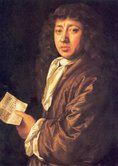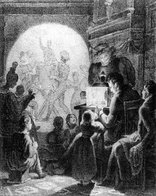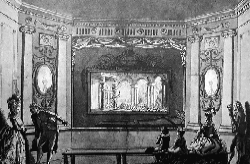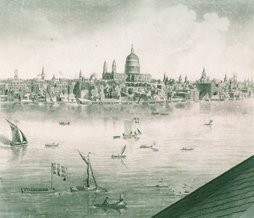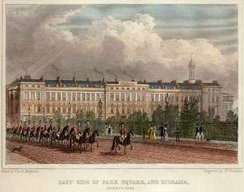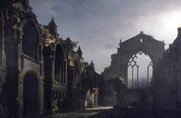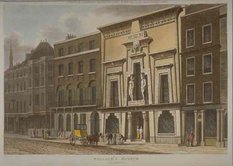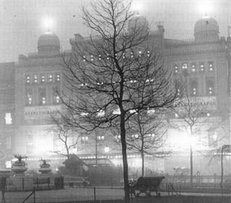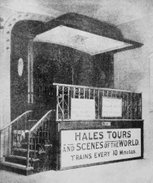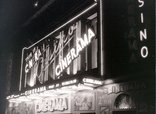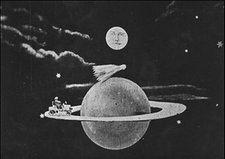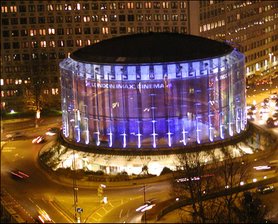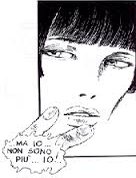Ian Christie
London Matters Now
London on Screen
New programme, Writing the City,
begins on 24 April 2012 with
Vanity Fair(Mira Nair, 2004)
Birkbeck Cinema, 2.30 pm
London Matters Past
2012
Dickens's London
Between January and April, London on Screen celebrated London's great chronicler and his screen adaptations over a century.
10 Jan Great Expectations (David Lean, 1946)
with John Mills, Alec Guiness
17 Jan The Life and Adventures of Nicholas Nickleby (Alberto Cavalcanti, 1947)
24 Jan Oliver Twist (David Lean, 1948) with John Howard Davis, Robert Newton
31 Jan David Copperfield (Thomas Bentley, 1913) accompanied by Stephen Horne
7 Feb A Tale of Two Cities (Ralph Thomas, 1958) with Dirk Bogarde, Dorothy Tutin
14 Feb The Houseless Shadow (William Raban, 2011); with Dickens’s London (1924)
21 Feb Little Dorrit (Christine Edzard, 1988) Pt 1: Nobody’s Fault with Derek Jacobi
28 Feb Little Dorrit Pt 2: Little Dorrit’s Story with Alec Guinness, Joan Greenwood
6 Mar Scrooge (Brian Desmond Hurst, 1951) with Alastair Sim, Jack Warner
13 Mar David Copperfield (George Cukor, 1935) with Freddie Bartholomew, W. C. Fields
20 Mar Oliver! (Carol Reed, 1968) with Ron Moody, Oliver Reed, Shani Wallis
2011
29 Mar :Workshop on Programming and Presenting London Archive Films Patrick Russell Curator of non-fiction at BFI National Archive, Luke McKernan curator of Moving Image, British Library, Ron Peck independent filmmaker (Nighthawks, Soho, Cross-Channel), Angela English co-author Screening our Memories, a toolkit on reminiscence work with film, Ian Christie director London Screen Studies Collection, curator and film historian
2010
10 May - 'From Muswell Hill to the Moon', a talk about early London filmmaking at the Institute of Historical Research, Senate House. Below: R W Paul's The ? Motorist (1906), made in Friern Barnet and Muswell Hill
7 Mar - Film & TV Walk around Muswell Hill.
Lost cinemas, the art-deco Odeon, site of R
W. Paul's studio and Ally Pally, birthplace
of British television.
2009
14 Oct - previewed Anthony Asquith's
restored Underground (1928) showing
in the London Film Festival on 23 Oct,
on Radio 3's Nightwaves
6 July - University of Paris Summer
School plenary on Screens Across the City,
from Panoramas to urban display
networks, via the century of 'cinema'
18 June - led a walk around film-related
sites in Haringey centred on Green Lanes.
Including locations for Face, TheLong Good
Friday and the early ex-Premier Cinema in
Turnpike Lane.
9/10 June - US archivist Paul Spehr was
in the UK as joint guest of Birkbeck and
BFI Southbank to talk about W K L
Dickson, the subject of his recent
biography, The Man Who Made Movies
(Libbey). Paul presented Dickson and
Edison films at the Barbican, BFI
Southbank and at Birkbeck.
7/8 June - British Silents Festival and the
Sounds of Early Cinema in Britain conference. During these two adjoining
events, I led a walk around early cinema
sites in central London, then
interviewed American conductor Gillian
Anderson after her brilliant performance
of the original music for Griffith's
Way Down East, and gave a paper about
musical accompaniment in London film
shows before 1914, at the Sounds conference.
5 June, Tate Britain - panel with Horace
Ove and Colin Prescod about the 70s
independent film scene and Pressure, as
part of The Story of London programme.
From Panoramas to IMAX
Screening the City: a sketch for the long history of
London screen entertainment
Ian Christie
What does ‘screen history’ mean? It can certainly be expanded beyond the era of cinema per se, since the work of several generations of historians of pre- and early cinema has demonstrated clearly that almost all the elements of the ‘cinema experience’ were in place before the actual mechanisms of moving pictures appeared at the ‘eleventh hour’ (in Laurent Mannoni’s phrase) of the 1890s.[1] It might more properly be considered a branch of entertainment history, with a particular emphasis on exploiting the illusory potential of the two-dimensional image. Such a definition would encourage thinking about the variables of such presentations – issues of location, competition, pricing – and the fact that although each strand has its own linear diachronic history,these were, and are, experienced synchronously by audiences. Screen history should therefore not merely be the taxonomy of various devices and ‘shows’ (Altick),[2] but an attempt to enter into the dynamic processes of production and consumption within the city (De Certeau).[3]
Screen entertainment in London must therefore be traced back to before the appearance of screens in music halls in the mid-1890s, or earlier in lecture theatres. The Lantern in its earliest, essentially domestic form, should probably be considered the starting point of a tradition of screened entertainment in the 17th century. Samuel Pepys wrote in his diary in August 1666:
comes by agreement Mr. Reeves… he bringing me a frame he closes on, to see how the rays of light do cut one another... He did also bring a lanthorne with pictures in glasse, to make strange things appear on a wall, very pretty […] and do like my glasse very well, and did even with him for it and a little perspective and the Lanthorne that shows tricks, altogether costing me £9 5s.0d.[4]
The collection of optical devices that Pepys bought from Robert Reeves included a telescope
and a prism, as well as the ‘lanthorne’ that showed ‘pretty pictures’ and ‘tricks’. These instruments would have been fashionable in the circles that Pepys frequented, shortly after a group of natural philosophers had founded the ‘Royal Society of London for Improving Natural Knowledge’.[5] Indeed we can trace a continuous tradition of use of the projecting lantern in scientific demonstration from the 17th century, after Christiaan Huygens and Athanasius Kircher first published accounts of its principles, to the present day, when PowerPoint fulfils a
similar purpose.[6]
Similarly, various forms of the lantern have been more or less continuously used for
domestic entertainment from Pepys’s time to the present. But my concern here is with forms of display intended for the public: a tradition of ‘screen entertainment’ that depends on some degree of spectacle, on showmanship and on a potential paying audience.
Just over a century after Pepys’s account, we find a remarkable succession of commercial displays that can be considered the foundation of London’s public screen entertainment between
the 1780s and the 1820s. Chronologically, the first of these was Philippe de Loutherbourg's
Eidophusikon, presented at various venues between 1781 and 1786. De Loutherbourg had trained as a painter in his native France before coming to England in 1771 and starting to work for the actor-manager David Garrick at the Drury Lane theatre. Here he soon developed a
reputation for remarkable lighting and scenic effects, which eventually led to the model theatre that he named Eidophusikon. In its first commercial presentation, in Lisle Street, this enabled an
audience of up to130 seated on benches in a darkened room to witness, through a proscenium
aperture about two metres by three, painted tableaux animated by shining light through taffeta,
with movable miniature models, accompanied by sound effects and music. Among the popular
subjects were the recent wrecking of a merchant ship, the Halsewell, and the Pandemonium
scene from Milton’s Paradise Lost.
De Loutherbourg described his entertainment as ‘movable paintings’ and press advertisements referred, for the first time, to ‘moving pictures’. Clearly the Eidophusikon represented an attempt to develop the painterly mise en scène that De Lourtherbourg had pioneered on stage (itself carrying forward the work of Inigo Jones for the Jacobean masque), miniaturising and mechanising such effects. In this, he might be seen as linking the passion for mechanical simulation of a slightly earlier period (La Mettrie etc) with the emerging aesthetic of Romanticism, to which he also contributed with his spectacular landscape paintings.[7]
In 1793, a decade after De Loutherbourg’s first presentations, another painter, Robert Barker, opened his Panorama in Leicester Square. This consisted of large 360° paintings, up to 1,100 sq metres, displayed within a cylindrical rotunda structure, with light entering from above.[8] Spectators were accommodated centrally on a viewing platform, and because of its size, the picture became ‘immersive’. Including three-dimensional elements in the foreground was later found to help create the illusion of a panoramic reality, and the viewer’s ability to move around the platforms and walkways, sometimes with a guide and the provision of telescopes, also contributed to the sense of ‘visiting’ the scene portrayed. Barker’s Panorama building in Cranbourne Street, on the north edge of Leicester Square, could accommodate a large and a small painting simultaneously, and his early subjects included a ‘View of the Grand Fleet’ and a ‘View of London and Westminster’. Naval and military scenes would remain popular throughout the life of the original Panorama, which remained in business under various proprietors until 1863. But despite Barker’s patent, imitations had appeared as early as 1796, with the Great Room in Spring Gardens and the Lyceum in the Strand popular London panorama venues. The idea quickly spread and during the following decades panoramas were constructed in many European cities, and toured to many provincial towns.
The Eidophusikon and panoramas had created a taste for dramatic visual spectacle, which must have paved the way for Paul de Philipsthal, also known as ‘Philidor’, to bring his Phantasmagoria to London in 1801 for a two-year run. Essentially an elaborate magic lantern show based on Gothic themes and using a movable lantern hidden behind the screen, this was first presented in Paris in 1792 by Philipsthal, and further developed by his rival Etienne-Gaspard Robertson before Philipsthal revived it in London. Mervyn Heard describes its effects as including
ancillary auditorium-based projections, thunder and lightning effects, ventriloquism, spine-tingling glass harmonica music, electric shocks, shadow-show effects, life-size masked figures, incense, smoke and... sensory deprivation.[9]
Philipsthal also showed automata at the Lyceum, and was joined by Marie Tussaud with her wax museum, which would prove to have a longer life than the Phantasmagoria and become a permanent feature of London entertainment.
Throughout the nineteenth and twentieth centuries, Leicester Square and the surrounding areas of Haymarket, Strand and Soho would remain central to large-scale and innovative screen entertainment. In 1851, the many established and ephemeral entertainments of Leicester Square were joined by Jonathan Wyld’s ‘Great Globe’, sixty feet in diameter and built in the centre of the square, either to compete with or capitalise on the popularity of the Great Exhibition then attracting record crowds to London. Wyld was a geographer and publisher of atlases, and his globe had the educational aim of offering a ‘tour’ of the physical world as visitors ascended its staircases. No doubt partly inspired by the success of the nearby Panorama (now known as Burford’s), it may also have owed something to the growing popularity of moving panoramas which simulated journeys of exploration, and of ballooning, with its novel aerial perspective. A contemporary account of visiting Wyld’s Globe reflected on the experience:
All the World is before you; you have only to choose where to go to. With a patriotic rush your eyes run to England, and you arc wonder-struck that a country which occupies so large a space in the thoughts of the world, should take up so little room on the surface of it. England, that has filled so many leaves in the world's history, is scarcely the size of a cabbage leaf; and London, which prides itself upon being the centre of civilization, is not half so big as TOM THUMB'S nose.[10]
But in 1823, the scene shifted north, with the opening of the Diorama in the newly laid out Regent’s Park. This was devised by Louis Daguerre, better known in media history as the official co-inventor of photography. Daguerre had previously worked on panoramas and was an accomplished painter of atmospheric landscapes and evocative buildings. His new entertainment, launched in Paris in 1822, provided the spectator with changing views of such scenes, achieved by painting on both sides of a large translucent canvas set at a distance, and controlling the play of light on these by means of coloured and opaque shutters. In the elegant purpose-built London building, 200 spectators could witness a gradual progression of lighting effects, from sunlight to cloud, on Trinity Chapel, Canterbury, or on Holyrood Palace, or even the emergence of ‘Ruins in a Fog’. By being able to rotate the entire viewing area, the audience could be transported magically from one such scene to another.
The effects of the Diorama were judged highly artistic and answered to a growing taste for such scenes, encouraged by Romantic poetry and novels. London’s first omnibus service linking Paddington Railway Station with the City ran through Regent’s Park and carried an advertisement for the Diorama, reinforcing the link between new forms of transport, especially the railway, and a new appetite for landscape viewed in motion. Daguerre’s Diorama was quickly imitated by other operators, notably Thomas Hamlet’s ‘British Diorama’ in the Royal Bazaar opened in 1828 on Oxford Street, and the term ‘dioramic’ began to be applied to large paintings, such as John Martin’s apocalyptic scenes. Meanwhile, Regent’s Park consolidated its newfound association with visual spectacle when a majestic new panorama, the Colosseum, opened close to the Diorama in 1829. The Colosseum’s main attraction was ‘London from the Summit of St Paul’s’, a painting of some 3, 660 sq metres based on drawings that had been executed in a special cabin built precariously on top of the cathedral. But its appeal was boosted by a number of other features, including London’s first hydraulic lift, to carry visitors up to the viewing platform, and a series of conservatories and smaller trompe l’oeil settings, such as a Swiss Cottage with simulated mountain views. Like the Queen’s Bazaar, with its shops and sideshows, the Colosseum was bidding to become a new kind of social space – and significantly, both would serve as backdrops for fashion plate advertisements.[11]
Alongside the new structures built specifically to house large-scale visual displays, nineteenth-century London saw a number of more traditional venues adapt to displaying screen entertainments. The facade of the Egyptian Hall in Piccadilly, commissioned in 1812 to house William Bullock’s collection of stuffed animals and exotic curiosities, was influenced by the discovery of Egyptian antiquity prompted by Napoleon’s expedition. Ironically, one of Bullock’s most successful presentations was of Napoleon’s coach in 1816, bought after Waterloo. In the 1820s, it was rented for many ephemeral shows, especially of large paintings that benefited from the ‘panoramic’ vogue, such as Benjamin Hayden’s Christ’s Entry into Jerusalem (1820) and later in the same year, Géricault’s Raft of the Medusa. In the 1850s, the Hall was particularly associated with the popular lecturer Albert Smith, whose account of climbing Mont Blanc, ‘accompanying the exhibition of cleverly-painted moving dioramic pictures and sublimities’, would continue for six years.[12] Later it would be most famous for Maskelyne and Cooke’s magic theatre presentations, under the by-line ‘England’s home of mystery’, avidly attended by Georges Méliès when he lived in London during 1884-5.
Another distinctive London venue that established a reputation for its projected entertainment was the Royal Polytechnic Institution in Upper Regent Street. Originally launched in 1838, this offered a typical Victorian mixture of spectacle and educational display, but its ‘dissolving views’, projected by up to six powerful lanterns on a screen eight metres wide in thre Great Hall and using special large-format slides, were considered outstanding. Accompanied by music, sound effects and narration, they became a major attraction, helping to keep the Polytechnic afloat until 1878. Its success owed much to ‘Professor’ John Pepper, originally a chemist, who served as director from 1852-72, successfully combined scientific demonstration with the popular illusion known as ‘Pepper’s ghost’, which created a spectral figure and on stage. But while the Polytechnic offered what was perhaps the ultimate refinement of the lantern show, the last street performers of ‘Chinese Shades’ were also active around Leicester Square and Regent Street, as recorded by Henry Mayhew.[13] Using candles and a portable booth that also served for Punch and Judy shows by day, they would present popular tales such as ‘Cobbler Jobson’ and ‘Billy Button’s Ride to Brentford’ to passers-by.
Projection was also the initial attraction of the Royal Panopticon, lavishly built in a Moorish style in Leicester Square in 1854. When the popular science programme proved uncommercial, the venue became the Alhambra Circus, trading on its imitation of the Moorish palace in Granada, and eventually a music hall in 1864. By this time, the music hall had become London’s fastest growing form of entertainment, helped by a strict prohibition on conventional drama that allowed only three ‘patent theatres’ to operate in London until the mid-19th century. The mixture of often bawdy songs, dancing and variety acts that characterised the music hall proved immensely profitable. Starting with the Canterbury in Lambeth and the Middlesex in Drury Lane, ornate venues opened throughout the East and West End, eventually fanning out into the new residential areas. By the late 1880s, the largest of these variety theatres, especially the Alhambra and Empire in Leicester Square, and the Tivoli in the Strand, offered a range of spectacular entertainment which would incorporate ‘animated photographs’ in 1896.
After near-simultaneous demonstrations in February 1896 of the Lumière Cinématographe at the Polytechnic and Robert Paul’s Theatrograph at the Royal Institution, the Empire and Alhambra respectively took these novelties into their programmes, where both continued for several years. Other music halls quickly followed suit, with a range of moving-picture presentations under various exotic titles. Many of these theatres would eventually become full-time cinemas, or would be demolished to make way for purpose-designed cinemas, such as the modernist Odeon Leicester Square, which replaced the Alhambra in 1937. Earlier, in 1909, the Palace Theatre of Varieties on Shaftesbury Avenue launched Charles Urban and G. A. Smith’s Kinemacolor process, and this continued until 1913 at the nearby Scala Theatre.
Many Londoners would first experience moving pictures in mission and church halls, which were quick to see the potential of attracting young viewers, as they had previously with magic lantern shows; or in fairgrounds, where showmen were also traditionally alert to novelty.
Full-time cinemas, which were more likely to be known as ‘bioscopes’, began to open around London in 1906, in locations near their likely audience of ‘city clerks seeking cheap, quick entertainment’, such as Bishopsgate, Brixton and Aldgate.[14] Jon Burrows has revealed the existence of at least 160 ‘nickelodeon-style shows, mostly housed in converted shops’ in London between 1906 and 1911,[15] while McKernan records the many unlicensed premises of 1907 giving way to a growing number of purpose-built cinemas after the passing of the 1909 Cinematograph Act. Entrepreneurs such as Montague Pyke launched chains of cinemas around the city with seating capacity that soon rose from around 500 to as many as 2000, in the case of the Grange Cinema, Kilburn, in 1914.[16]
By 1927, when Warners’ venture into synchronised sound launched the ‘Talkies’, London was exceptionally well provided with a range of different sizes of cinema, ranging from the ‘supers’ which showed new films first, down to neighbourhood ‘fleapits’ that showed these later and more cheaply. Variety shows reappeared in cinemas in the 1920s and continued until after World War 2. In the 1930s, two major cinema chains would transform the face of film exhibition in Britain. Gaumont and Odeon cinemas featured distinctive design, the latter often streamlined modernist, and luxurious interior fittings as the setting in which British film production attracted its largest domestic audience during the 1940s. London’s suburbs benefited particularly from the two chains, with Odeons becoming the centrepiece of new shopping centres and remaining the backbone of the city’s film exhibition base until the 1990s. Thereafter, the multiplex model led a revival of cinema building around Britain, from which eventually reached London, with such developments as Whiteleys in Bayswater embedding a cinema complex in a new shopping mall.
Novelty, however, has continued to play a part in London’s screen entertainment. Montagu Pyke was inspired to launch his cinema chain by seeing the success of a ‘Hale’s Tours of the World’ show on Oxford Street in 1906. This international attraction placed spectators in a mock railway carriage, with specially shot films that reproduced the view through a moving window.[17] Large cinemas of the 1920s would often feature exotic foyer decoration that could extend into the main auditorium, with lighting effects to simulate a twilight sky. In the 1950s, as audiences began to decline, forms of ‘wide screen’ presentation were introduced and central London cinemas served as flagship venues for these. The Prince Edward Theatre in Old Compton Street was adapted for Cinerama in 1957 and in 1959 the Empire Leicester Square presented Ben Hur in 70mm for 76 weeks. Giant IMAX projection, recalling the impact of the panorama, first appeared in London at the Science Museum, before a dedicated IMAX rotunda was built in partnership with the British Film Institute at Waterloo. Large video display units at all London rail stations have now joined the traditional sites of advertising display, such as Piccadilly Circus, presenting programmes of news, information and advertising to commuters and passers by. And Trafalgar Square hosts regular open-air screenings of classic silent films and London archive material, with live accompaniment, as well as live transmissions from the Royal Opera House.
This brief account of the ‘long history’ of London screen entertainment does not offer any thesis, much less aim to be comprehensive. Like Birkbeck’s ‘London Project’ on which it partly draws, its intention is to promote the ‘social turn’ in screen studies, and demonstrate in outline what a more comprehensive history of London screen entertainment might reveal about the city and its ‘imaginary’.[18]
January 2010
Note: This essay originated in a lecture given at the 2008 Sorbonne Nouvelle-Paris 3 Summer School. An incomplete text was inadvertently included in the collection of presentations, Extended Cinema: le cinema gagne du terrain,eds. Philippe Dubois, Frederic Monvoisin, Elena Biserma, Campanotto Editore, 2010.
[1] Major contributions to establishing the pre-history of cinema range from C. W Ceram, Archaeology of Cinema, translated by Richard Winston, London: Thames & Hudson, 1965, to Laurent Mannoni, The great art of light and shadow: archaeology of the cinema. Translated and edited by Richard Crangle. Exeter: University of Exeter Press, 2000.
[2] A key work for London entertainment history is Richard D. Altick, The Shows of London, Cambridge, Mass: Bellhknap Press, 1978. Unfortunately Altick’s great trawl ends in the mid-19th century.
[3] Drawing on De Certeau’s invaluable ‘practices of everyday life’, Michel de Certeau, L’Invention du quotidian, vol. 1, Arts de faire, Paris: Gallimard, 1998
[4] Diary of Samuel Pepys, 19 and 22 August 1666, accessed at http://www.pepys.info/1666/1666aug.html
[5] See Robert Hooke, writing about the value of the lantern in the Royal Society’s Philosophical Transactions, vol 3, 17 August 1668, pp741-743; also history of the Royal Society, at http://royalsociety.org/History-of-the-Royal-Society/
[6]Athanasius Kircherhas traditionally been credited as inventor of the Magic Lantern, due to his account in the 1671 edition of his Ars Magna Lucis et Umbrae. But Christiaan Huygens had built a lantern by 1659, and Reeves was manufacturing them from 1663. See ‘History of the Magic Lantern’, Magic Lantern Society (UK), http://www.magiclantern.org.uk/history/history4.html
[7] De Loutherbourg’s most famous painting, Coalbrookdale by Night (1801), has come to stand for the Romantic appeal of the Industrial Revolution, showing the flaring iron works at night. A set model for his 1793 pantomime interlude, The Wonders of Derbyshire, survives.
[8] Information on Barker’s and other panoramas predominantly from Ralph Hyde, Panoramania! The Art and Enterainment of the ‘All-embracing’ View, London: Trefoil/Barbican Art Gallery, 1988, pp. 57-64; also Bernard Comment, The Panorama, London: Reaktion, 1999, pp. 23-26.
[9] Heard, in D. Robinson, S. Herbert, R. Crangle, eds., Encyclopedia of the Magic Lantern, Ripon, Yorks.: The Magic Lantern Society, 2001, p. 228.
[10]Punch, July-December, 1851; quoted at http://www.victorianlondon.org/districts/leicestersquare.htm
[11] Benjamin Read’s fashions were displayed in the Queen’s Bazaar n 1833 (Hyde, p. 121) and in the Colosseum in 1836 (Hyde, p. 92). See Ralph Hyde and Valerie Cumming, ‘The Prints of Benjamin Read, Tailor and Printmaker’, Print Quarterly, Sept 2000. Accessed at http://www.motco.com/BenjaminRead/article.asp.
[12] John Timbs, Curiosities of London, 1867, quoted at http://www.victorianlondon.org/entertainment/egyptianhall.htm.
[13] Henry Mayhew, London Labour and the London Poor, vol 3, 1851; available in the Tufts Digital edition at http://dl.tufts.edu/view_text.jsp?urn=tufts:central:dca:UA069:UA069.005.DO.00079&chapter=c2s7.
[14] On the growth of cinemagoing in London, see Luke McKernan, ‘Diverting time: London’s cinemas and their audiences, 1906-14, The London Journal, vol. 32, no. 2, July 2007, accessible at http://www.lukemckernan.com/LDN2202.pdf. This was an output of The London Project, part of the AHRB Centre for British |Film and Television Studies: see also the database on early London cinema businesses maintained at http://londonfilm.bbk.ac.uk/
[15] Jon Burrows, ‘Penny Pleasures: Film exhibition in London during the nickelodeon era, 1906-1914’, Film History, vol. 16, 2004, pp. 60-91.
[16] Luke McKernan, ‘Unequal Pleasures: Electric Theatres (1908) and the early film exhibition business in London’ (2006), available at http://www.lukemckernan.com/unequal_pleasures.pdf. On the Grange Cinema, see http://www.tnunn.ndo.co.uk/grange.htm.
[17] See Hale’s Tours entry by Lauren Rabinowitz in R. Abel, ed., Encyclopedia of Early Cinema, Abingdon: Routledge, 2005, pp. 293-4; also http://londonfilm.bbk.ac.uk/view/venue/?id=996
[18] The London Project, studying the development of London’s film businesses from 1895-1914, formed part of the AHRC Centre for British Film and Television Studies (2000-2006); and its preliminary findings and outputs can be located through http://londonfilm.bbk.ac.uk.
Links to other activities and events
Copyright ® 2009 webc.ianchristie.org
